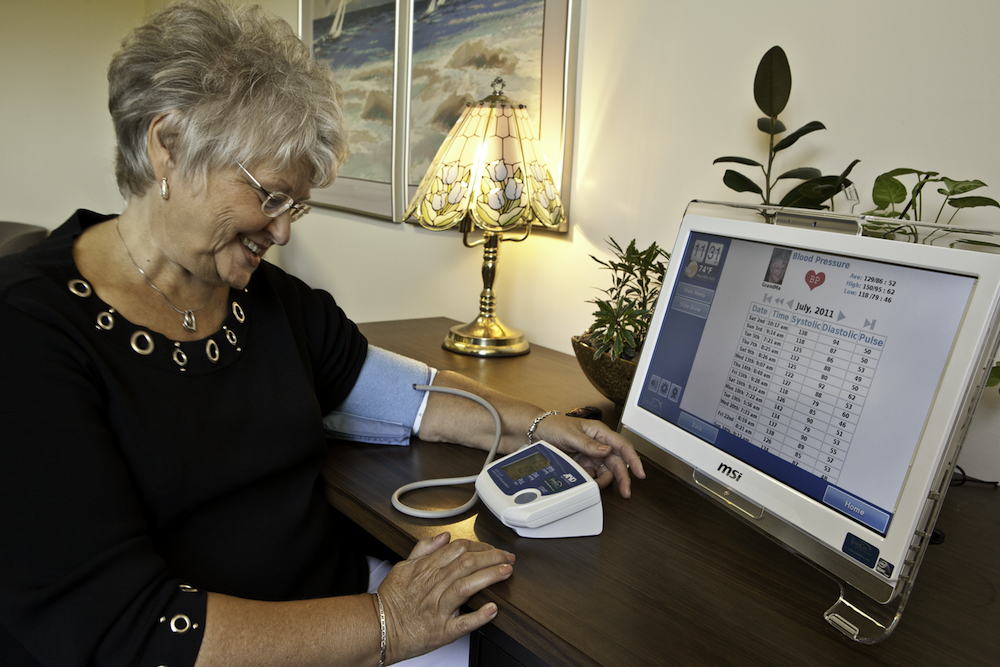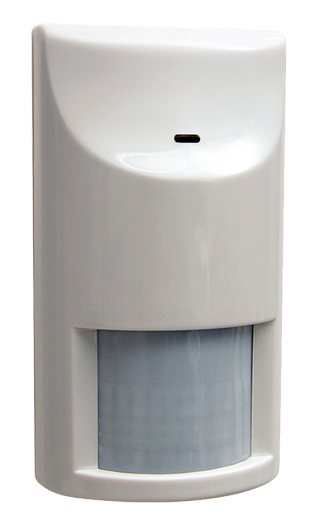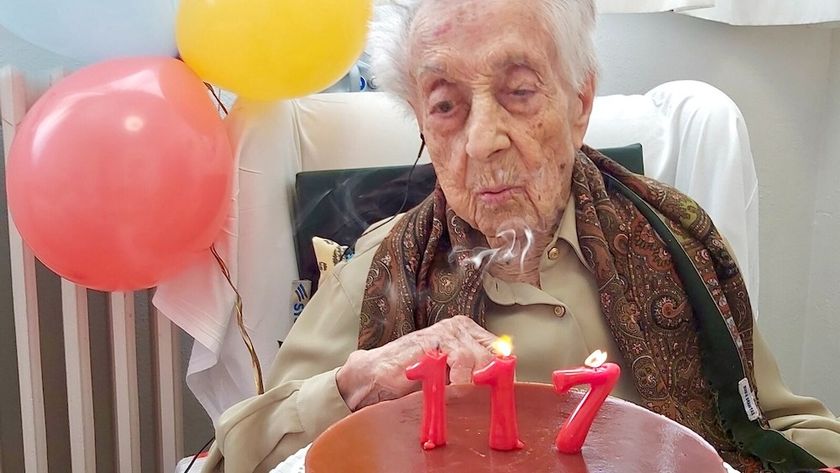'Nana Tech': Smart Shoes & Handheld EKGs Could Keep Seniors Safe

Imagine this scenario: It's a cold night in Iowa, or Georgia, or Maine. Your elderly father, who has Alzheimer's disease, is supposed to be in bed. But when you check on him, he's gone.
It's a nightmare that anyone who cares for a person with dementia fears: that their loved one will wander and not be found until it's too late. In fact, 40 percent of people with dementia get lost at some point, and 5 percent get lost repeatedly, according to a 1998 study in the International Journal of Geriatric Psychiatry.
In February, a 72-year-old man with Alzheimer's disease died after wandering onto a stranger's porch in rural Georgia, according to news reports. The homeowner's fiancé, 35-year-old Joe Hendrix, fatally shot the older man.
But taking care of elderly parents — or being one yourself — could get a bit easier in the near future, thanks to technology designed to keep seniors safe.
(Check out a sister site of Live Science's called Dignifyed, which has in-depth reviews of medical alert systems and expert advice related to health and wellness for older people.)
One proponent of this tech, Andrew Carle of George Mason University, refers to it as "nana technology," a pun on "nanotechnology," for the unobtrusive size of these new devices. One device that Carle consulted on is a GPS-enabled shoe sole designed to help caregivers keep track of patients with dementia. New wearables like the shoe sole are a discreet alternative to wrist or ankle bands.
"There's no stigma," Carle told Live Science.
Sign up for the Live Science daily newsletter now
Get the world’s most fascinating discoveries delivered straight to your inbox.
Destigmatizing tech
Stigma has long been a problem for medical alert devices. In 1987, medical alert company Life Call put out an infamous (and unintentionally campy) commercial for its emergency pendant, which allowed seniors to press a panic button in the event of a medical crisis or fall. The commercial made "I've fallen, and I can't get up!" a national punch line. [Top 10 Stigmatized Health Disorders]
No one wants to be associated with the frail grandma, lying fallen next to her walker. While medical pendants are still available, the newest generation is sleeker and less noticeable. And many companies are offering not only radio-frequency devices, which have a short range from their base unit, but also devices that work with Wi-Fi or on cellular networks.
"People don't have to be prisoners in their own home," Carle said. "You can go out and get the mail. It's being able to go to the store, to church, walk around the block."
Those walks are important, he added. If a senior gets a medical alert system that limits him or her to an area the size of a few hundred feet, it can discourage him or her from exercising.
Carle is a consultant for the company GTX, which has been selling GPS-enabled Smart Shoes for patients with Alzheimer's and other forms of dementia since 2011. Recently, the company announced an even more elegant solution: The GPS SmartSole. This device consists of a shoe sole that can be cut to fit any shoe, enabled with a GPS tracker. The SmartSoles will be available later this year, he said.
Caregivers can set up a virtual "geofence" of any size for the wearer of the shoe. When the person crosses that line, the caregiver will get an alert. The GPS will then send coordinates showing the lost person's location within about 3 feet (1 meter), Carle said.
The price of the SmartSole is not yet public, but GTX's GPS shoes retail for $299.99. There are other, cheaper options, such as Comfort Zone, a cellphone-like GPS locator sold by The Alzheimer's Association. Of course, these devices are not foolproof, as they rely on access to satellite signals to triangulate location. They also require a monthly cellular plan and rely on battery power.
Unlike radio-frequency systems that can automatically lock doors when an Alzheimer's patient approaches, GPS systems don't keep patients inside the geofence; they still require close monitoring. But Carle said the extra freedom given by a GPS tracker can let an Alzheimer's patient sit on the porch without raising alarms.
Additionally, paranoia is a primary symptom of Alzheimer's, and patients who feel they are being tracked and trapped can become stressed and panicky, Carle said.
"I know of seniors with Alzheimer's who have broken their wrist trying to get those things off," Carle said.
Smart homes for seniors

Other new systems are designed to prevent problems. For example, the technology company GrandCare uses smart sensors to monitor an elderly person's home. The system retails for $699, plus the cost of any additional sensors, and a monthly $49 fee. Buyers get a console that acts as a one-stop shop for email, calendars and reminders to take medication. The sensors track activity, creating a daily schedule.
With GrandCare, relatives or caregivers can sign up to receive alerts if the schedule goes awry. For example, a caregiver might want to know if mom doesn't get out of bed in the morning, or if she doesn't open the fridge at lunchtime, said Laura Mitchell, the company's vice president of business development.
"If I take a look at what's going on with my mom and say, 'Wow, she used the bathroom 14 times last night,' that's something she might not share," Mitchell told Live Science. "We've had cases where people were sleepwalking and didn't know it."
For seniors, the future is likely to be full of wearables, modeled after the consumer fitness trackers that monitor heart rate and exercise, Mitchell said. [Read More: Best Fitness Tracker Brands]
"You'll see little handheld EKGs [electrocardiograms] and things like that, and you'll see a lot of disposable smart shirts and smart bandages that can take your heart rate," she said. Smart thermometers or spirometers (which measure breathing) could also help seniors measure their vital signs at home, saving them trips to the doctor or hospital. Staying home can save patients from catching hospital-acquired infections, Mitchell said.
Carle's vision of the future includes smart underwear, and clothes embedded with sensors to measure heart rate, respiration, perspiration, body temperature and oxygen levels. Such clothing could save medically fragile people from even having to take their own vitals, and may be on the market in 10 to 15 years, he said. Accelerometers (already present in some emergency medical pendants) could automatically detect falls and alert emergency medical technicians.
Smart fabrics could even be engineered to expand and contract if the wearer's heart stops, Carle said.
"Now you're talking about your underwear giving you CPR while it calls an ambulance," he said. "This is all way, way beyond 'I've fallen and I can't get up.'"
Follow Stephanie Pappas on Twitter and Google+. Follow us @livescience, Facebook & Google+. Original article on Live Science.

Stephanie Pappas is a contributing writer for Live Science, covering topics ranging from geoscience to archaeology to the human brain and behavior. She was previously a senior writer for Live Science but is now a freelancer based in Denver, Colorado, and regularly contributes to Scientific American and The Monitor, the monthly magazine of the American Psychological Association. Stephanie received a bachelor's degree in psychology from the University of South Carolina and a graduate certificate in science communication from the University of California, Santa Cruz.












